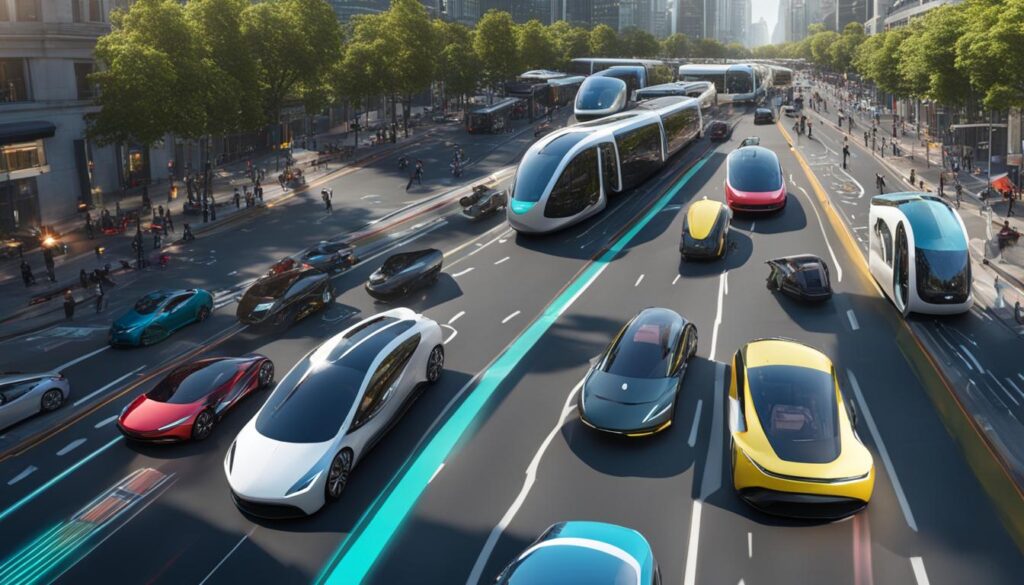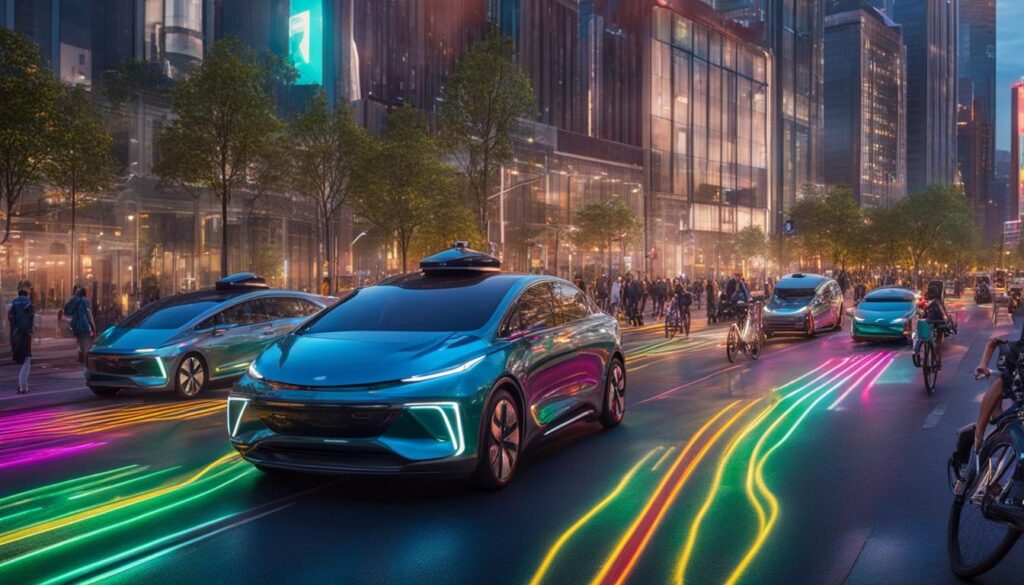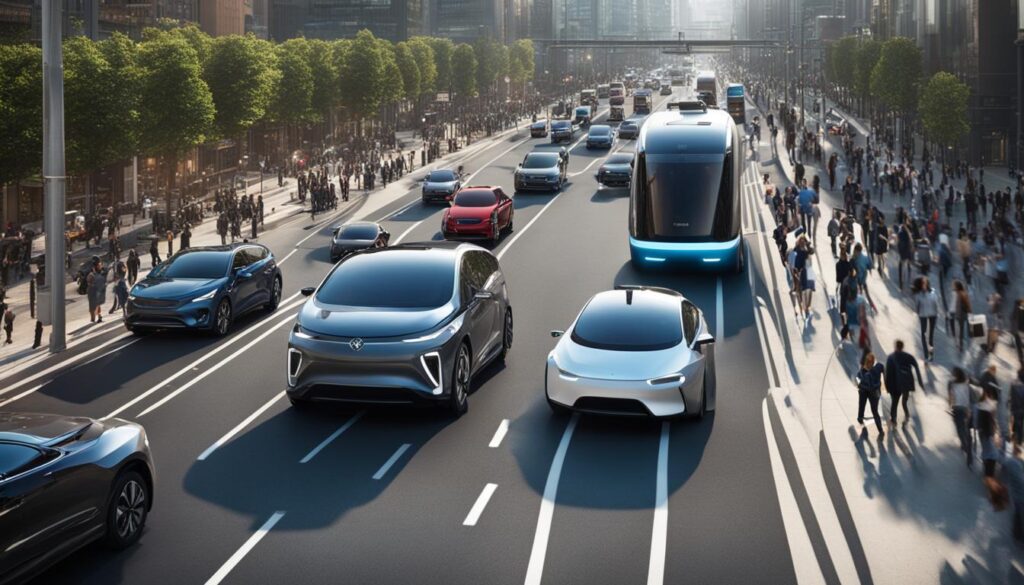The progress in smart transportation technologies and self-driving vehicles is revolutionizing how Americans travel. Developments in transport tech, together with the integration of autonomous vehicles and driverless autos, are bringing the concept of intelligent transportation options into reality.
Key Takeaways:
- Intelligent transport systems and autonomous vehicles are transforming the way we travel.
- Advancements in transportation technology enable the integration of connected vehicles and self-driving cars.
- The aim is to improve driving safety, reduce traffic accidents, and provide efficient and sustainable smart mobility solutions.
- Intelligent control systems based on edge computing and deep learning enhance the stability and safety of autonomous vehicles.
- The integration of artificial intelligence in transportation drives the development of intelligent and automated driving systems.
The Benefits of Intelligent Transport Systems and Autonomous Vehicles
Intelligent transport systems and autonomous vehicles offer numerous benefits for individuals and society as a whole. These innovative technologies have the potential to revolutionize transportation by making it more efficient, safe, and sustainable. With the integration of connected vehicles and self-driving cars, the future of smart transportation solutions is becoming a reality.
One of the key advantages of intelligent transport systems and autonomous vehicles is improved road safety. By utilizing advanced sensors and artificial intelligence algorithms, self-driving cars can detect potential hazards and react faster than human drivers. This can lead to a significant reduction in traffic accidents and fatalities caused by human errors. Additionally, autonomous vehicles have the potential to optimize traffic flow and reduce congestion, increasing road capacity and minimizing the need for parking spaces.
Another significant benefit of intelligent transport systems and autonomous vehicles is their potential contribution to environmental sustainability. By optimizing driving patterns and reducing traffic jams, these technologies can improve fuel efficiency and reduce emissions. This has a positive impact on air quality and the overall carbon footprint of transportation. Moreover, the integration of autonomous vehicles can also free up valuable land that is currently used for parking spaces, allowing for more green spaces and sustainable urban development.
“Intelligent transport systems and autonomous vehicles have the potential to transform transportation, making it more efficient, safe, and sustainable.”
In conclusion, intelligent transport systems and autonomous vehicles offer significant benefits for both individuals and society. These technologies have the potential to improve road safety, reduce congestion, and contribute to environmental sustainability. However, it is crucial to address the challenges associated with the development and integration of these technologies, such as safety, legal and regulatory frameworks, and public acceptance. With collaboration between industry, government, and academia, we can unlock the full potential of intelligent transport systems and autonomous vehicles, creating a future where transportation is smarter, safer, and more sustainable.

The Challenges of Intelligent Transport Systems and Autonomous Vehicles
As we delve into the world of intelligent transport systems and autonomous vehicles, we encounter a range of challenges that need to be addressed. One of the primary challenges lies in ensuring the safety and reliability of these technologies. Self-driving cars must operate in complex and unpredictable environments, making accurate decisions in real-time. It is crucial to develop robust artificial intelligence algorithms that can handle various road and weather conditions to ensure the safety of both passengers and pedestrians.
Another obstacle we face is the establishment of a legal and regulatory framework surrounding autonomous vehicles. As technology continues to evolve, clear guidelines and standards need to be established to ensure the safe operation of self-driving cars. This includes addressing liability issues, determining who is responsible in the event of an accident, and establishing protocols for cybersecurity and data privacy.
Public acceptance and trust in the technology also present a significant challenge. Many individuals still have reservations about autonomous vehicles and may be hesitant to fully embrace them. Addressing concerns related to safety, job displacement, and the overall impact on society is essential to gain public acceptance and facilitate the widespread adoption of these transformative technologies.

Table: Challenges of Intelligent Transport Systems and Autonomous Vehicles
| Challenge | Description |
|---|---|
| Safety and Reliability | Ensuring the safe operation of self-driving cars in complex and unpredictable environments. |
| Legal and Regulatory Framework | Establishing clear guidelines and standards to regulate the operation and deployment of autonomous vehicles. |
| Public Acceptance and Trust | Addressing concerns and building public acceptance and trust in autonomous vehicles. |
Overcoming these challenges requires collaboration between industry, government, and academia. By working together, we can develop robust and reliable technologies, establish appropriate regulations, and educate the public about the benefits and safety measures associated with autonomous vehicles. The challenges we face today are stepping stones towards a future of efficient and sustainable transportation, where intelligent transport systems and autonomous vehicles play a pivotal role.
The Role of Edge Computing in Intelligent Transport Systems
Edge computing plays a vital role in the development and implementation of intelligent transport systems (ITS) by enabling real-time data processing and communication. With the increasing complexity and volume of data generated by connected vehicles and autonomous vehicles, traditional centralized cloud computing infrastructures are no longer sufficient to meet the demands of ITS. Edge computing brings computation and data storage closer to the source of data generation, allowing for faster decision-making and reduced latency.
One of the key advantages of edge computing in ITS is its ability to enable decentralized data processing. In the context of connected and autonomous vehicles, this means that vehicles can communicate with each other and make quick decisions without relying solely on a centralized processing system. By distributing the processing power closer to the vehicles, edge computing enhances the overall responsiveness and safety of the intelligent transport system.
Additionally, edge computing allows for more efficient use of network resources. Instead of transmitting all the data generated by connected and autonomous vehicles to a central server, edge computing enables the processing and analysis of only relevant data at the edge. This reduces bandwidth requirements and improves the scalability of the system. By optimizing data transmission and reducing network congestion, edge computing contributes to the seamless integration of connected and autonomous vehicles in ITS.
| Advantages of Edge Computing in Intelligent Transport Systems |
|---|
| Faster decision-making and reduced latency |
| Decentralized data processing and communication |
| Improved responsiveness and safety of the transport system |
| Efficient use of network resources |
| Reduced bandwidth requirements and improved scalability |
Overall, edge computing plays a crucial role in the successful implementation of intelligent transport systems and the seamless integration of connected vehicles and autonomous vehicles. By enabling real-time data processing, decentralized communication, and efficient use of network resources, edge computing enhances the safety, responsiveness, and scalability of the intelligent transport system.

Deep Learning and Artificial Intelligence in Autonomous Vehicles
Deep learning and artificial intelligence (AI) play a pivotal role in the development and operation of autonomous vehicles. With the help of advanced algorithms and computational capabilities, autonomous vehicles can perceive, learn, and make decisions based on real-time data from their surroundings. The integration of deep learning and AI technologies enables autonomous vehicles to adapt to changing road conditions, navigate complex environments, and ensure safe and efficient driving.
Deep learning algorithms, such as Convolutional Neural Networks (CNN), are used to analyze and interpret sensor data from the environment. By continuously learning from large datasets, autonomous vehicles can improve their perception and decision-making capabilities. These algorithms allow vehicles to recognize and classify objects, such as pedestrians, other vehicles, and traffic signs, aiding in the navigation and detection of potential hazards.
In addition to perception, artificial intelligence algorithms manage and coordinate the various control functions of the vehicle. These algorithms govern acceleration, braking, steering, and trajectory tracking, ensuring smooth and safe maneuvers. By leveraging AI, autonomous vehicles can make informed decisions, optimize driving patterns, and adapt to dynamic road conditions, ultimately enhancing driving safety and efficiency.
| Key Points | Benefits |
|---|---|
| Deep learning algorithms enable autonomous vehicles to analyze sensor data and recognize objects. | Improved perception and hazard detection. |
| Artificial intelligence algorithms govern control functions, such as acceleration, braking, and steering. | Safe and efficient driving maneuvers. |
| Continuous learning from large datasets enhances decision-making capabilities. | Adaptation to changing road conditions and optimization of driving patterns. |
With ongoing research and innovation in deep learning and AI, autonomous vehicles will continue to evolve, pushing the boundaries of what is possible in transportation. As technology advances, we can expect improved accuracy, robustness, and real-time decision-making capabilities in autonomous vehicles, making our roads safer and more efficient.
The Future of Intelligent Transport Systems and Autonomous Vehicles
The future of intelligent transport systems and autonomous vehicles holds great promise for the transformation of transportation. As technology continues to advance, we can expect to see increased adoption and integration of autonomous vehicles into our daily lives. This will not only change the way we travel but also have a profound impact on urban planning, infrastructure, and the overall mobility ecosystem. The integration of intelligent transport systems and autonomous vehicles will enable the development of smart cities, where transportation is efficient, safe, and environmentally friendly. It will also open up new opportunities for innovative business models and services, such as on-demand transportation and mobility-as-a-service.
However, realizing the full potential of intelligent transport systems and autonomous vehicles requires collaboration between industry, government, and academia, as well as addressing the technical, regulatory, and societal challenges that lie ahead.
One of the key challenges is ensuring the safety and reliability of autonomous vehicles. Self-driving cars need to be able to operate in complex and unpredictable environments, making accurate decisions in real-time. This requires robust artificial intelligence algorithms that can handle various road and weather conditions. Additionally, there is a need for clear guidelines and standards to ensure the safe operation of self-driving cars. Governments and regulatory bodies must work together to establish a legal framework that promotes the development and deployment of autonomous vehicles while ensuring the safety of all road users.
Another challenge is gaining public acceptance and trust in autonomous vehicles. Many people still have reservations about self-driving cars and may be hesitant to embrace them fully. Education and awareness campaigns are crucial to address misconceptions and build trust in the technology. It is important to demonstrate the benefits of autonomous vehicles, such as improved road safety, reduced congestion, and increased accessibility, to gain public support for their integration into our transportation systems.
| Challenges | Actions Required |
|---|---|
| Ensuring safety and reliability | Development of robust AI algorithms and establishment of clear guidelines and standards |
| Gaining public acceptance and trust | Educational campaigns and demonstration of the benefits of autonomous vehicles |
| Addressing legal and regulatory issues | Collaboration between governments and regulatory bodies to establish a legal framework |
The future of intelligent transport systems and autonomous vehicles is a shared responsibility. By working together, we can overcome the challenges and pave the way for a future where transportation is safer, more efficient, and more sustainable. We have the opportunity to shape the future of mobility and create a transportation system that benefits us all.

Implications of Autonomous Vehicles on Safety and Public Behavior
As autonomous vehicles become more prevalent on the roads, it is important to consider the implications they have on safety and public behavior. Studies have shown that autonomous vehicles have the potential to significantly reduce traffic accidents caused by human errors. With their advanced sensors and artificial intelligence algorithms, self-driving cars can detect potential hazards and react faster than human drivers. This has the potential to make our roads safer for everyone.
However, there are also concerns about the behavior of both the autonomous vehicles and other road users. Some studies have found that pedestrians may exhibit riskier behavior around autonomous vehicles, assuming that they will yield or react in certain ways. This highlights the need for education and awareness campaigns to ensure that both the general public and autonomous vehicle users understand the capabilities and limitations of the technology. By promoting safe road behavior and fostering greater understanding, we can create a harmonious and safe environment for autonomous vehicles and other road users.
“The introduction of autonomous vehicles has the potential to significantly impact safety and public behavior on the roads.”
Addressing the issue of public behavior extends beyond pedestrians. It also includes the behavior of human drivers in the presence of autonomous vehicles. As autonomous vehicles become more prevalent, it is crucial for human drivers to understand how to interact with them on the road. This includes following traffic rules, giving autonomous vehicles ample space, and respecting their right-of-way. By promoting responsible driving behavior, we can ensure a smooth transition to a future where autonomous vehicles coexist with human drivers.
Overall, while autonomous vehicles have the potential to greatly improve road safety, it is important to address public behavior and ensure that all road users understand how to safely interact with autonomous vehicles. By fostering education, awareness, and responsible behavior, we can create a safer and more harmonious environment on our roads.

Key Takeaways:
- Autonomous vehicles have the potential to significantly reduce traffic accidents caused by human errors.
- Educating the public about the capabilities and limitations of autonomous vehicles is crucial for promoting safe road behavior.
- Responsible behavior from both pedestrians and human drivers is necessary for a smooth transition to a future with autonomous vehicles.
Impact of Autonomous Vehicles on Land Use, Economy, and Environment
Autonomous vehicles have the potential to greatly impact various aspects of society, including land use, economy, and the environment. As self-driving cars become more prevalent, we can expect to see changes in how land is utilized, as well as shifts in the economy and environmental sustainability.
One of the key impacts of autonomous vehicles is on land use. With the introduction of self-driving cars, there may be a reduced need for traditional parking spaces. Autonomous vehicles can drop off passengers and continue on to their next destination, eliminating the need for parking. This opens up valuable land that was previously used for parking to be repurposed for other purposes, such as green spaces or commercial development.
The economy will also experience changes with the rise of autonomous vehicles. The autonomous vehicle industry is expected to create new job opportunities, such as vehicle maintenance and software development. As the technology advances, there will be a need for skilled workers to support the growth of autonomous vehicles. Additionally, the integration of autonomous vehicles into transportation systems can lead to increased efficiency and productivity, which can have positive economic effects.
From an environmental standpoint, autonomous vehicles have the potential to contribute to a more sustainable transportation system. With optimized driving patterns and reduced traffic congestion, fuel efficiency can be improved, resulting in reduced emissions. This can have a significant impact on air quality and reduce the carbon footprint of transportation. However, it is important to carefully consider the potential negative impacts, such as increased vehicle miles traveled and urban sprawl, and mitigate them through effective planning and policy implementation.
Table: Environmental Impact of Autonomous Vehicles
| Impact | Description |
|---|---|
| Reduced Emissions | Autonomous vehicles can optimize driving patterns and reduce traffic congestion, leading to improved fuel efficiency and reduced emissions. |
| Air Quality | By reducing the number of vehicles on the road and optimizing driving patterns, autonomous vehicles can help improve air quality in urban areas. |
| Carbon Footprint | The increased fuel efficiency and reduced emissions of autonomous vehicles can help decrease the carbon footprint of transportation, contributing to global efforts to combat climate change. |
| Urban Sprawl | There is a potential risk of increased urban sprawl as the ease of autonomous vehicle travel may encourage people to live further away from city centers, leading to increased commuting distances. |
In summary, the impact of autonomous vehicles on land use, economy, and the environment is significant. With the potential for reduced parking needs, new job opportunities, and improved fuel efficiency, autonomous vehicles have the potential to reshape our urban landscape, boost the economy, and contribute to a more sustainable transportation system. However, careful planning, policy implementation, and consideration of potential negative impacts are necessary to ensure that the development and integration of autonomous vehicles are carried out in a responsible and sustainable manner.
Challenges and Ethical Considerations in the Development of Autonomous Vehicles
As the development of autonomous vehicles continues to progress, it is important to address the challenges and ethical considerations that arise. There are several key challenges that need to be overcome in order to ensure the safe and responsible integration of autonomous vehicles into our transportation system. One of the main challenges is the establishment of clear regulations and standards that govern the operation of autonomous vehicles. These regulations need to address issues such as liability, cybersecurity, and data privacy to protect both the users and the public.
Another challenge is the ethical considerations surrounding the decision-making algorithms of autonomous vehicles. In critical situations, such as when an accident is unavoidable, autonomous vehicles need to make split-second decisions that prioritize the safety of their occupants versus the safety of pedestrians or other road users. Establishing a framework for these ethical decisions is crucial to ensure that autonomous vehicles act in the best interest of society as a whole.
Public acceptance is also a significant challenge in the development of autonomous vehicles. Many people still have reservations about self-driving cars and may be hesitant to trust them fully. Addressing public concerns through education and transparency is essential to build trust and acceptance towards autonomous vehicles.
The Role of Regulations in Ensuring Safety
Regulations play a crucial role in ensuring the safe and responsible development and deployment of autonomous vehicles. These regulations need to cover various aspects, including technical standards, safety requirements, and operational guidelines. By establishing clear and comprehensive regulations, policymakers can foster an environment that encourages innovation while protecting public safety.
| Challenges | Ethical Considerations | Regulations | Public Acceptance |
|---|---|---|---|
| Establishing clear regulations and standards | Ethical decision-making algorithms | Technical standards and safety requirements | Addressing public concerns through education and transparency |
| Ensuring liability, cybersecurity, and data privacy | Ensuring the safety of occupants and pedestrians | Operational guidelines | Building trust and acceptance |
| Acting in the best interest of society |
“The development of autonomous vehicles brings both challenges and ethical considerations that require careful consideration. By addressing issues such as clear regulations, ethical decision-making algorithms, and public acceptance, we can ensure the safe and responsible integration of autonomous vehicles into our transportation system.”
In conclusion, the development of autonomous vehicles presents several challenges and ethical considerations. Establishing clear regulations and standards, addressing ethical decision-making algorithms, and building public acceptance are key factors in ensuring the safe and responsible integration of autonomous vehicles into our transportation system. By working together, industry leaders, policymakers, and the public can pave the way for a future where autonomous vehicles contribute to safer, more efficient, and sustainable transportation.
Current Research and Innovation in Intelligent Transport Systems and Autonomous Vehicles
In the field of intelligent transport systems and autonomous vehicles, ongoing research and innovation are driving technological advancements and shaping the future of transportation. Researchers and industry experts are continuously working towards developing new algorithms, sensor technologies, and communication systems to enhance the performance and safety of autonomous vehicles. The aim is to create smarter, more efficient, and reliable transportation solutions.
One area of focus is the improvement of artificial intelligence algorithms used in autonomous vehicles. These algorithms enable vehicles to better understand and respond to complex road conditions, enhancing their perception and decision-making capabilities. By continuously learning from vast datasets, autonomous vehicles can continuously improve their driving capabilities and adapt to changing environments.
Moreover, researchers are exploring ways to enhance connectivity and communication between autonomous vehicles and infrastructure. This involves integrating intelligent transport systems with traffic signals, road sensors, and other infrastructure components to optimize traffic flow and improve overall transportation efficiency. Emerging technologies, such as 5G connectivity and blockchain, are also being investigated for their potential to enhance the capabilities of intelligent transport systems.
The Role of Research and Innovation:
Innovation and research in the field of intelligent transport systems and autonomous vehicles are driving the development of cutting-edge technologies that are shaping the future of transportation. Through continuous research and innovation, we are making significant strides towards creating safer, more efficient, and sustainable transportation solutions.
As the research and innovation in intelligent transport systems and autonomous vehicles continue, we can expect to see further advancements in technology and a broader range of applications. This will not only enhance the performance and safety of autonomous vehicles but also contribute to the development of smart cities and more sustainable transportation systems. Collaboration between industry, government, and academia remains crucial to driving the research and innovation needed for the successful integration of intelligent transport systems and autonomous vehicles into our daily lives.
The Role of Policy and Industry Collaboration in the Advancement of Intelligent Transport Systems and Autonomous Vehicles
The advancement of intelligent transport systems and autonomous vehicles requires a collaborative effort between policymakers, industry leaders, and academia. Our collective efforts in policy and industry collaboration are crucial for driving the development, deployment, and integration of intelligent transport systems and autonomous vehicles into our transportation ecosystem.
Policies play a vital role in creating an enabling environment for the safe and responsible adoption of autonomous vehicles. Clear and consistent regulations are needed to ensure the safety, security, and privacy of autonomous vehicle users. Governments and regulatory bodies must work together to establish guidelines and standards that address technical, legal, and ethical considerations. By establishing a robust regulatory framework, we can address public concerns and foster public acceptance of autonomous vehicles.
Industry collaboration is essential for driving innovation, sharing knowledge, and accelerating the advancement of intelligent transport systems. Collaboration between automakers, technology companies, and transportation service providers allows for pooled resources, shared best practices, and a faster pace of development. By sharing insights and expertise, industry leaders can overcome challenges, address technical limitations, and drive the widespread adoption of intelligent transport systems and autonomous vehicles.
“Industry collaboration allows us to leverage our collective strengths and expertise to overcome challenges and drive the future of intelligent transport systems and autonomous vehicles. By working together, we can create a transportation ecosystem that is more efficient, safe, and sustainable.”
The collaboration between academia and industry is also critical for bridging the gap between research and industry implementation. By fostering partnerships between researchers and industry experts, we can facilitate knowledge transfer, test innovative ideas, and develop practical solutions. The integration of academic research into industry practices helps ensure that intelligent transport systems and autonomous vehicles are grounded in robust scientific principles and best practices.
The role of policy and industry collaboration in the advancement of intelligent transport systems and autonomous vehicles cannot be overstated. It is through our collective efforts that we can unlock the full potential of these technologies and shape the future of transportation.
Conclusion
The development of intelligent transport systems and autonomous vehicles is revolutionizing the way America travels. With advancements in transportation technology, including connected vehicles, self-driving cars, and deep learning algorithms, the future of mobility is becoming more efficient, safe, and sustainable.
The integration of edge computing and artificial intelligence in transportation is enabling real-time data processing, communication, and intelligent control of autonomous vehicles. By leveraging edge computing, vehicles can make quick decisions and communicate with each other, improving overall responsiveness and safety.
However, the widespread adoption and integration of intelligent transport systems and autonomous vehicles come with their own set of challenges. Ensuring safety, addressing legal and regulatory issues, and gaining public acceptance are key hurdles to overcome. By proactively addressing these challenges and working collaboratively, we can unlock the full potential of intelligent transport systems and autonomous vehicles. Together, we can pave the way for a future where transportation is more efficient, safe, and environmentally friendly.
The future of mobility is here, and the possibilities are endless. As technology continues to advance, we can expect to see increased adoption and integration of autonomous vehicles into our daily lives. This will not only change the way we travel but also have a profound impact on urban planning, infrastructure, and the overall mobility ecosystem. Let us embrace these innovations and work towards a future where intelligent transport systems and autonomous vehicles enhance our lives and create a more connected and sustainable society.
FAQ
What are intelligent transport systems and autonomous vehicles?
Intelligent transport systems refer to the integration of advanced technologies, such as sensors, artificial intelligence, and connectivity, in transportation to improve safety, efficiency, and sustainability. Autonomous vehicles, also known as self-driving cars, are vehicles that can operate without human intervention, using artificial intelligence algorithms and sensors to navigate and make decisions on the road.
What are the benefits of intelligent transport systems and autonomous vehicles?
Intelligent transport systems and autonomous vehicles offer numerous benefits, including improved road safety, reduced traffic accidents, increased road capacity, reduced congestion, improved fuel efficiency, and reduced emissions. These technologies also have the potential to transform transportation, making it more efficient, safe, and sustainable.
What are the challenges of intelligent transport systems and autonomous vehicles?
The challenges of intelligent transport systems and autonomous vehicles include ensuring the safety and reliability of the technology, establishing clear legal and regulatory frameworks, addressing public acceptance and trust in the technology, and overcoming technical, regulatory, and societal challenges.
What is the role of edge computing in intelligent transport systems?
Edge computing plays a crucial role in enabling real-time data processing and communication in intelligent transport systems. It brings computation and data storage closer to the source of data generation, reducing latency and enabling faster decision-making. Edge computing allows for decentralized data processing in connected and autonomous vehicles, improving responsiveness and safety.
How does deep learning and artificial intelligence contribute to autonomous vehicles?
Deep learning and artificial intelligence algorithms are at the core of autonomous vehicles’ intelligent control systems. Deep learning algorithms analyze sensor data to recognize objects and make informed decisions. Artificial intelligence algorithms manage and coordinate the vehicle’s control functions. These technologies enable autonomous vehicles to adapt to changing road conditions and ensure safe and efficient driving.
What does the future hold for intelligent transport systems and autonomous vehicles?
The future of intelligent transport systems and autonomous vehicles holds great promise for transforming transportation. As technology advances, we can expect increased adoption and integration of autonomous vehicles, leading to more efficient, safe, and sustainable mobility solutions. These technologies have the potential to create smart cities and open up new opportunities for innovative business models and services.
What are the implications of autonomous vehicles on safety and public behavior?
Autonomous vehicles have the potential to improve road safety by reducing human errors. However, there are concerns about public behavior around autonomous vehicles and the need for education and awareness campaigns to ensure understanding of the technology’s capabilities and limitations. Clear regulations and standards are also necessary for safe operation and interaction with other road users.
How do autonomous vehicles impact land use, the economy, and the environment?
The introduction of autonomous vehicles may reduce the need for traditional parking spaces and create new job opportunities in the industry. They can also improve fuel efficiency and reduce emissions, contributing to a more sustainable transportation system. However, there may be potential negative impacts, such as increased vehicle miles traveled and urban sprawl, which need to be carefully considered and planned for.
What are the challenges and ethical considerations in the development of autonomous vehicles?
The challenges include establishing clear legal and regulatory frameworks, addressing public acceptance and trust, and ensuring the safety and reliability of the technology. Ethical considerations include the decision-making algorithms of autonomous vehicles in critical situations and balancing the safety of occupants versus other road users. Responsible development and deployment require addressing these challenges and ethical considerations.
What is the current research and innovation in intelligent transport systems and autonomous vehicles?
Researchers and industry experts are constantly working on developing new algorithms, sensor technologies, and communication systems to enhance the performance and safety of autonomous vehicles. There is also a focus on improving artificial intelligence algorithms and exploring emerging technologies, such as 5G connectivity and blockchain, to enhance intelligent transport systems.
What is the role of policy and industry collaboration in the advancement of intelligent transport systems and autonomous vehicles?
Policies and regulations are crucial in creating an enabling environment for the development and deployment of autonomous vehicles. Industry collaboration facilitates innovation, resource sharing, and accelerated adoption of intelligent transport systems. Collaboration with academia helps bridge the gap between research and industry, facilitating knowledge transfer and practical solutions.









